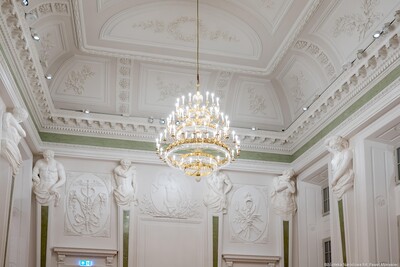The Palace of the Commonwealth and the adjacent Krasiński Garden form a palace-cum-garden complex (French: entre cour et jardin) which was typical of the Baroque style. Built in the years 1688–1699, according to Tylman van Gameren’s design, was unanimously considered by the contemporaries as one of the most beautiful magnate palaces in Warsaw.
The construction of the Krasiński Palace was a manifestation of great political ambitions of Jan Dobrogost Krasiński (1639–1717), voivod of Płock voivodship and starost of Warsaw. Following the example of other magnates he desired to build in Warsaw a magnificent residence, which would confirm the prestige of the Krasiński family and its graciousness would equal or even exceed the palace constructed at that time for King John III Sobieski in Wilanów.
The design of the palace was to refer to the mythical roots of the Krasiński family, which was traced back to the legendary Roman patrician Marcus Valerius Corvinus. Highlighting one’s ancient genealogy, which was at that time widespread among highly placed Polish nobility, elevated the position of a family and was an expression of their social and political aspirations. The topic of the sculptural décor of the palace, which has been admired until today, was subordinated to that principle.
In 1765, the edifice, until then called the Krasiński Palace, was bought by the Crown Treasury Commission and became a government facility. From that time on the Palace would perform supreme state functions.
At the beginning of the 1770s the building was remodelled according to Jakub Fontana’s design, though already in December 1982 it was almost entirely consumed by a fire. It was restored according to Domenico Merlini’s design in the following year. In 1796, after the 3rd partition of Poland and liquidation of the Polish state, a humiliating ceremony of putting down signatures of fealty to the King of Prussia was organized in the Palace.
In 1807–1812, the building housed public institutions of the Duchy of Warsaw, and at the times of the Kingdom of Poland (1815–1918) the Palace first served as the seat of Tsarist authorities (Council of State, Government Commission of Justice, Clearing House and General Bank), and afterwards, until the January Uprising (1863), as the residence of the head of the civilian administration of the Kingdom, margrave Aleksander Wielopolski. After the January Uprising, the Palace was taken over by the Tsarist judicature and was the seat of the Russian Palace of the Courts of Justice.
At that time, it was also subject to ill-conceived and unsightly modernizations which deprived it of its hitherto noble appearance (among other things, the cartouche of the Krasiński family coat-of-arms was hacked off).
Upon the end of World War I the edifice was taken over by newly established Polish institutions. In January 1917, the Palace of the Commonwealth was transferred to the Polish Interim Council of State in the Kingdom of Poland which was the germ of Polish statehood. In the 2nd Republic of Poland (1918–1939) the Palace housed the Supreme Court. In 1929, the building was revitalised; among other things, new cartouches with the coat-of-arms of the Republic.
World War II was the most tragic period in the history of the Building. During the Warsaw Uprising the Palace was a defence point manned by the Parasol scouting battalion. On 27 August 1944, three German planes dropped bombs which turned the residence into ruin.
The reconstruction was started in 1948 and lasted until 1961, when the Palace was handed over to shelter the most valuable collections of the National Library which survived the war.
In the years 2014–2016, it underwent thorough revitalisation under the “Conservation and revitalization of the Krasiński Palace (Palace of the Commonwealth) in Warsaw – European 2014–2016 century cultural heritage” Project, co-financed with the funds of the 2009–2014 EEA Financial Mechanism and domestic funds.
| Day of the week | Opening hours | |
|---|---|---|
| Monday | 11:00 - 19:00 | |
| Wednesday | 11:00 - 19:00 | |
| Thursday | 11:00 - 19:00 | |
| Friday | 11:00 - 19:00 | |
| Saturday | 11:00 - 19:00 | |
| Sunday | 11:00 - 19:00 |
| Holidays | Opening hours |
|---|---|
| 2025.04.20 (Sunday) | x |
| 2025.04.21 (Monday) | x |
| 2025.05.01 (Thursday) | x |
| 2025.05.03 (Saturday) | x |
| 2025.06.19 (Thursday) | x |
| 2025.08.15 (Friday) | x |
| 2025.11.01 (Saturday) | x |
| 2025.11.11 (Tuesday) | x |
| 2025.12.25 (Thursday) | x |
| 2025.12.26 (Friday) | x |
| Tickets | |
|---|---|
| free admission | |
| when? | name | where? | about what? | for free | for children | |
|---|---|---|---|---|---|---|
 | Permanent exhibition Permanent exhibition | The Palace of the Commonwealth (Krasiński Palace) pl. Krasińskich 3/5 00-207 Warszawa Mazowieckie | literature, music | yes |